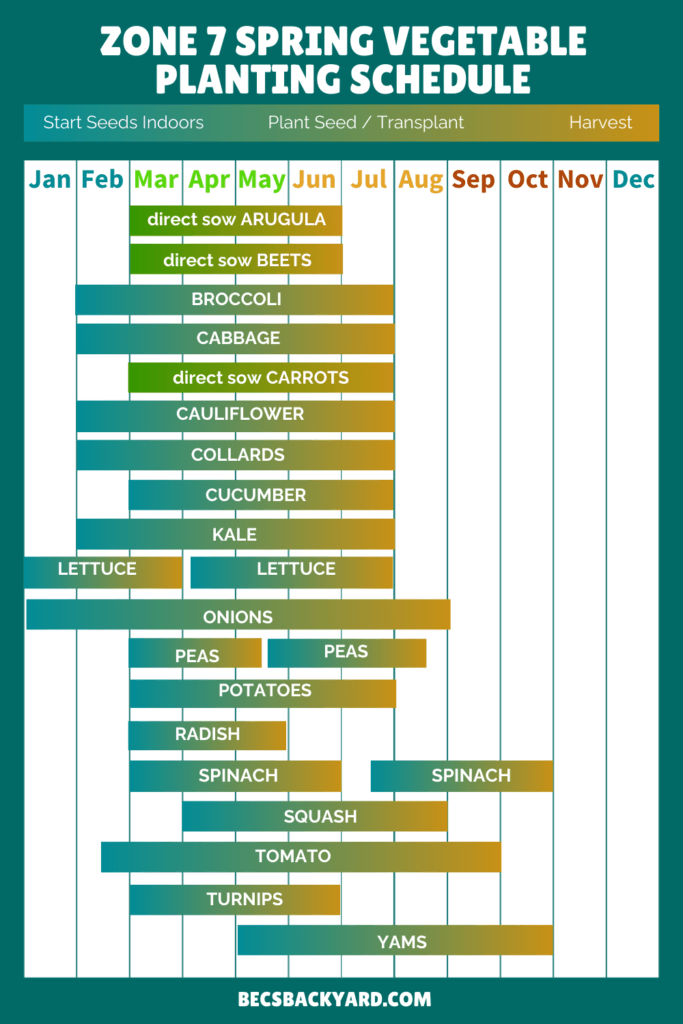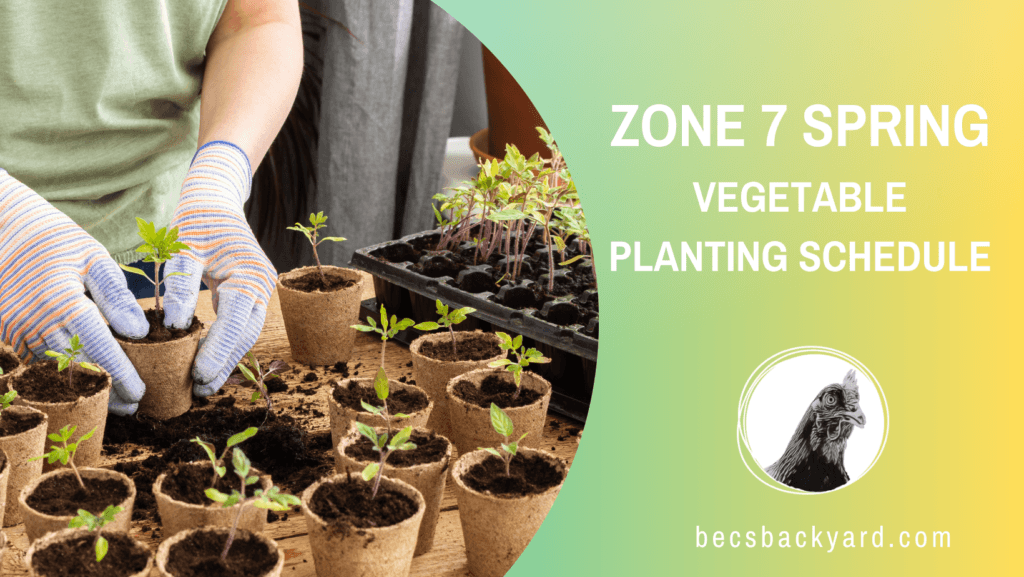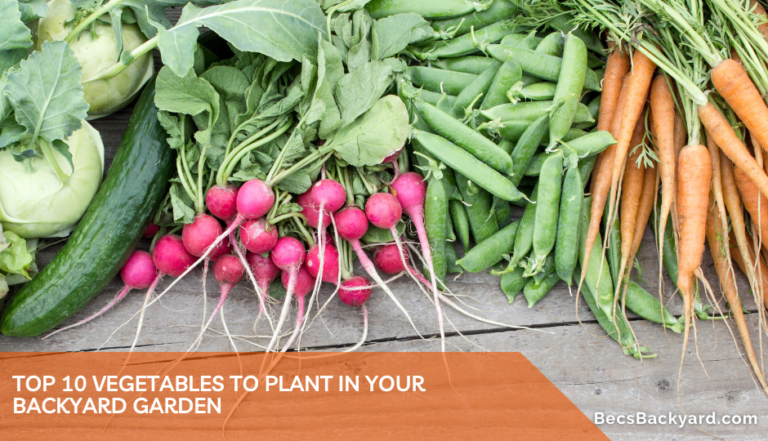Zone 7 Spring Vegetable Planting Schedule: Your Guide to Timely Garden Success

Zone 7 Spring Vegetable Planting Schedule is what all gardeners living in Zone 7 need to start thinking about before the end of of winter. Gardeners in Zone 7 enjoy a favorable climate for growing a diverse range of vegetables. This region encompasses a wide geographical area with a medium-length growing season that typically starts after the last frost date around April 15. The relatively long period until the first fall frost around November 15 provides ample time for both cool and warm-season crops.
Spring in Zone 7 signals the start of the gardening season, and a carefully planned planting schedule is crucial for success. As temperatures begin to rise, it is essential to know which vegetables to sow directly into the soil and which to start indoors for later transplanting. Early spring is ideal for planting cool-weather crops, while certain heat-loving vegetables should be sown or transplanted after the threat of frost has passed to ensure optimal growth.
Creating a vegetable garden in Zone 7 requires attention to timing and variety selection. Knowing the specific needs of each vegetable, from soil temperature to sun exposure, helps gardeners maximize their gardens’ productivity. A well-structured planting calendar serves as a valuable guide for when to plant seeds and seedlings outdoors and sets up expectations for harvesting times throughout the growing season.
Understanding Zone 7 Climates
Understanding the climate and weather patterns in Zone 7 is essential for optimal planting. Knowing the last frost date is critical for scheduling when to plant vegetables.
Climate and Weather Patterns
Zone 7 features a temperate climate with a medium-length growing season that is conducive to a wide range of vegetables. The weather is characterized by warm summers and cool winters, with average minimum winter temperatures ranging between 0 to 10 degrees Celsius (32 to 50 degrees Fahrenheit). Spring often sees a gradual increase in temperature, conducive to starting many types of vegetable seeds.
Determining the Last Frost Date
The last frost date in Zone 7 typically falls between April 15th and April 30th. However, these dates can vary slightly depending on specific local conditions. Gardeners must pay attention to local weather forecasts and historical data, as the last frost date directly impacts when to safely plant temperature-sensitive vegetables outdoors. It is advisable to plan for a buffer period after the last expected frost date to avoid damage to young plants from unanticipated late-season frost.

Zone 7 Spring Vegetable Planting Schedule : Planning Your Vegetable Garden
Proper planning is essential for creating a thriving vegetable garden in Zone 7. It ensures the selection of suitable vegetables that align with regional climate conditions, as well as thoughtful garden plot design and comprehensive soil preparation.
Selecting Suitable Vegetables
When choosing vegetables for a Zone 7 garden, gardeners should consider the region’s last expected frost date, typically occurring in early spring. They should prioritize vegetables that flourish in the moderate climate of Zone 7 and adhere to the specific growing seasons of each plant type. Recommendations include:
- Leafy Greens: spinach, kale, and lettuce, ideal for early planting.
- Root Vegetables: carrots, beets, and radishes, suitable for both spring and autumn seasons.
- Fruiting Vegetables: tomatoes, peppers, and cucumbers, which require warmer temperatures.
Garden Plot Design and Soil Preparation
The layout of the vegetable garden can significantly impact its productivity. Gardeners should:
- Design plots with ample space for each plant, ensuring sufficient air circulation and sunlight exposure.
- Create paths to allow easy access without compacting the soil around plants.
Soil preparation is pivotal, as it nourishes plants and promotes robust growth. The following steps are critical:
- Test the Soil: Assess pH levels and nutrient content to identify amendments needed.
- Enrich the Soil: Incorporate organic matter like compost to improve fertility.
- Till the Soil: Loosen the soil to enhance aeration and water absorption, being careful to preserve soil structure.
Starting Seeds Indoors
In Zone 7, starting seeds indoors is an essential step to ensure a robust and timely harvest. Gardeners must carefully manage timing and techniques for starting seeds and have a solid plan for transplanting the seedlings outdoors.
Timing and Techniques
The timing for starting seeds indoors in Zone 7 typically ranges from 2 to 16 weeks before the last expected frost date. Most vegetables, such as tomatoes and peppers, benefit from being started 6-8 weeks prior to transplanting. Gardeners can accelerate seedling growth by providing consistent warmth and using grow lights to simulate longer daylight hours.
Seed Starting Timeline
- Tomatoes: 6-8 weeks before last frost
- Peppers: 6-8 weeks before last frost
- Lettuce: 4-6 weeks before last frost
- Cucumbers: 4-6 weeks before last frost
Seed-starting mixes and small pots are ideal to start with, and seeds should be kept moist but not waterlogged. A thin layer of vermiculite can aid in moisture retention. The use of fertilizer should be minimal until seedlings have a couple of true leaves, at which point a half-strength liquid fertilizer can encourage growth.
Transplanting Seedlings
Transplanting begins after the danger of frost has passed and seedlings have developed strong root systems. It’s crucial to harden off seedlings by gradually exposing them to outdoor conditions over a period of 7-10 days. This process reduces transplant shock and increases survival rates.
Transplant Readiness Criteria
- 2-3 sets of true leaves
- Stout and short stature
- No flowering
Once seedlings meet these criteria, they can be carefully transplanted to their outdoor beds or containers, ensuring adequate spacing for mature growth. Remember to water adequately after transplanting to help the seedlings establish in their new environment.
Direct Sowing and Transplanting
In Zone 7, the spring planting schedule hinges on understanding the right time for direct sowing and the proper methods for transplanting young plants. Tailoring actions to specific crops ensures robust growth and optimizes the harvest.
Best Practices for Outdoor Planting
When planting outdoors, one should consider the soil temperature and the local frost dates. Seeds of cool season vegetables can be sown directly into the garden as they tolerate lower temperatures and can often withstand a light frost. Such crops include lettuce, kale, and peas. Warm-season crops, however, such as tomatoes and peppers, should be transplanted only after the danger of frost has passed and the soil has warmed.
Soil preparation is critical; it should be well-draining, fertile, and rich in organic matter. Seeds must be sown at the correct depth, which varies by type of crop—consult the seed packet for instructions. Transplanted seedlings should be hardened off to acclimate them to outdoor conditions before planting.
Sowing Schedule for Key Crops
The schedule below outlines when to direct sow or transplant key crops in Zone 7:
- Cool season vegetables (e.g., spinach, radishes)
- Direct sow as early as 4-6 weeks before the last frost date.
- Peas
- Direct sow around the last frost date, which is approximately April 15th for Zone 7.
Warm-season crops such as tomatoes and peppers, on the other hand, should be started indoors 6-8 weeks before the last frost date and transplanted after the threat of frost is gone and soil temperatures reach at least 60°F.
For both directly sown seeds and transplants, spacing is crucial to avoid overcrowding and to ensure proper air circulation, which minimizes disease risk. Regular watering, especially during dry periods, will support steady growth and development of young plants.
Maintenance and Care
Proper maintenance and care are crucial for a successful vegetable garden in Zone 7 during the spring growing season. Adequate watering, appropriate fertilization, and diligent pest and disease management are essential. Gardeners should adhere to a schedule and employ effective strategies to ensure the health and productivity of their plants.
Watering and Fertilizing
Watering should be consistent and adjusted according to rainfall; vegetables typically require an inch of water per week. Drip irrigation or soaker hoses are recommended to provide deep watering that reaches the root systems. Gardeners should water in the early morning to minimize evaporation and fungal diseases.
When it comes to fertilizing, a soil test can determine nutrient needs. A balanced, slow-release fertilizer applied at planting and periodically during the growing season can benefit plant growth. Organic options, such as compost or fish emulsion, can provide nutrients while improving soil health.
| Fertilizer Type | Application Timeframe | Benefit |
|---|---|---|
| Balanced | At planting & periodically | Supports general plant needs |
| Nitrogen-rich | During leafy growth stages | Enhances foliage development |
| Phosphorus-rich | Before flowering and fruiting | Encourages root and fruit growth |
| Potassium-rich | Before harvest | Aids in disease resistance & yield |

Weatherly Organics Vegetable Fertilizer Spikes

- Nutrient-Rich Boost: Weatherly Organics Vegetable Fertilizer Spikes provide a targeted and nutrient-rich feeding solution that promotes robust growth and fruiting of your vegetable plants.
- Easy Application: These convenient spikes are designed for effortless use. Simply insert them into the soil around your vegetable plants to deliver a steady and consistent nutrient supply.
- Balanced Formula: The fertilizer spikes offer a well-balanced blend of essential nutrients, including nitrogen, phosphorus, and potassium, tailored to the specific needs of vegetables.
- Sustainable Nourishment: Weatherly Organics is committed to environmentally conscious practices. These fertilizer spikes promote healthy soil ecosystems, supporting sustainable gardening.
- Long-Lasting Results: With slow-release technology, these spikes provide ongoing nourishment for several weeks, ensuring your vegetable garden thrives with lush foliage and abundant produce.
Pest and Disease Management
Pest management starts with prevention; crop rotation and choosing disease-resistant varieties can reduce problems. Regular inspection of plants is necessary to catch issues early. Physical barriers, such as netting or row covers, help to keep pests away, while insecticidal soaps or neem oil can address infestations without harming beneficial insects.
Disease management requires a proactive approach. Mulching can prevent soil-borne diseases from splashing onto plants. Proper spacing between plants is important for good air circulation, which minimizes fungal and bacterial diseases. Remove and destroy infected plant material promptly to prevent the spread of disease.
| Strategy | Purpose | Implementation |
|---|---|---|
| Crop rotation | Prevents soil-borne pest buildup | Change plant families in the same plot |
| Resistant varieties | Reduces occurrence of diseases | Select plants bred for disease resistance |
| Physical barriers | Keeps pests from reaching plants | Use floating row covers or garden netting |
| Organic pesticides | Controls pest without chemicals | Apply insecticidal soap or neem oil |
By following these practices, Zone 7 gardeners can effectively maintain their spring vegetable gardens, ensuring a healthy environment for their plants to thrive throughout the growing season.
Harvesting and Beyond
In Zone 7, the timing of harvests and prepping for the off-season is crucial for a successful garden year-round. Gardeners must pay close attention to the growing season and be mindful of first frost dates to protect their investment and ensure their efforts yield the fullest harvest.
When and How to Harvest
Cool-weather crops like lettuce and spinach are typically ready for harvesting in the early part of the growing season, while warm-season crops such as tomatoes and peppers mature later. Gardeners should:
- Monitor plants closely as the season progresses.
- Harvest vegetables when they are at peak ripeness for the best flavor and nutrition.
- Use the first frost date as a guide to harvest tender crops before damaging frosts occur, typically around early to mid-fall in Zone 7.
Perennials, including asparagus and rhubarb, berry bushes, and fruit trees, will have varied harvest times throughout the spring and summer. They should be harvested:
- As soon as berries and fruits are ripe to prevent overripening on the branch.
- Regularly, to stimulate further fruit production throughout the season.
Preparing for the Off-Season
As the end of the growing season approaches, Zone 7 gardeners must prepare for the colder months:
- First frost dates serve as an important reminder to start winterizing the garden.
- Mulching perennials, like berry bushes, can provide protection from frost and help soil retain warmth.
- Cool-weather crops can extend the harvest season and should be planted in late summer or early fall.
Enacting these steps ensures perennial plants and the overall garden are safeguarded and can offer a robust start for the next growing season.
Frequently Asked Questions
In this section, readers will find concise answers to common queries on spring vegetable planting in USDA Zone 7, including timing, variety selection, and cultivation tips.
What vegetables grow best in Zone 7?
In Zone 7, a variety of vegetables thrive due to the moderate climate. Cool-season crops such as leafy greens, peas, and root vegetables do well, as do warm-season vegetables like tomatoes, peppers, cucumbers, and squash once the threat of frost has passed.
When is the optimal time to start planting my spring vegetable garden in Zone 7?
Gardeners in Zone 7 should begin planting cool-season crops as early as March. For warm-season vegetables, it is advisable to wait until after the last frost date, typically around April 15th, to ensure that the soil temperature is suitable for germination and growth
What is the last frost date for Zone 7 to safely plant tender spring vegetables?
The last frost date for Zone 7 is generally around April 15th. This is a crucial date to remember when planting frost-sensitive vegetables to avoid potential damage from late spring cold snaps.
Can you recommend a planting schedule for starting seeds indoors in Zone 7?
Starting seeds indoors for Zone 7 should be timed so that transplanting occurs after the last frost date. For most vegetables, this means starting seeds indoors approximately 6-8 weeks before April 15th.
How does the planting schedule differ for Zones 7a and 7b?
Zones 7a and 7b differ slightly in their average last frost dates, with 7a typically a couple of weeks earlier. Planting schedules should be adjusted accordingly, with gardeners in 7b being able to plant a bit earlier in the spring.
What are some general tips for maintaining a healthy vegetable garden throughout the spring season in Zone 7?
Consistent watering, mulching, and monitoring for pests and diseases are vital for a healthy spring vegetable garden in Zone 7. Cool-season crops may need protection from late frosts, and warm-season vegetables should be planted when the soil has adequately warmed.








